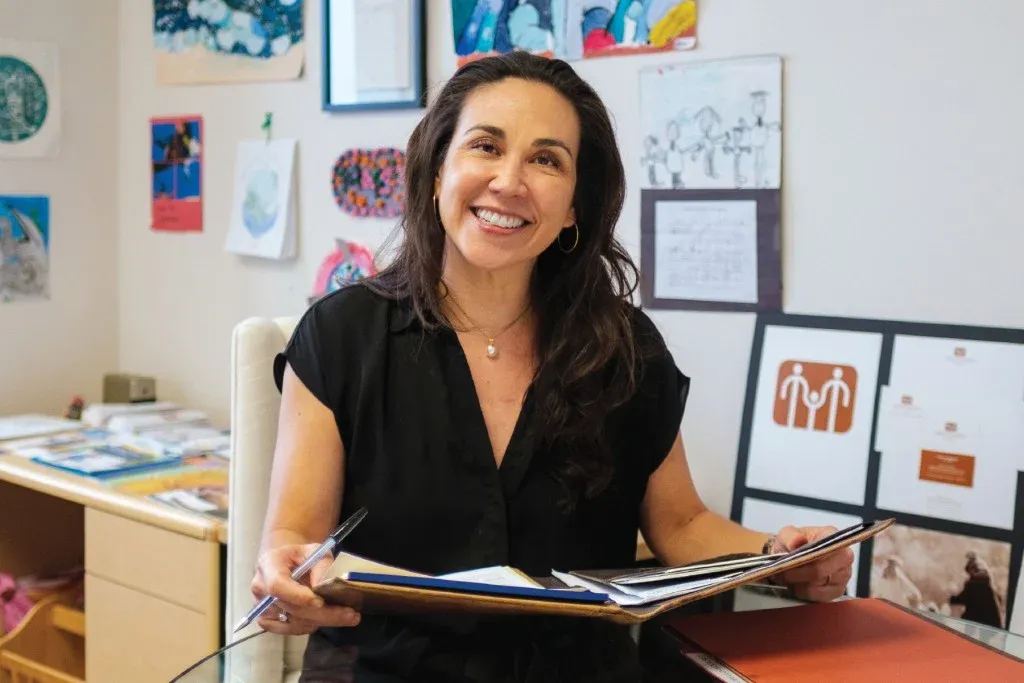Blog

Surviving Divorce: From Scary Story to Success Story Like a Halloween tale that starts with fog rolling in and shadows lengthening, divorce can cast an eerie pall over your once-familiar life. The financial uncertainties, changing relationships, and unfamiliar terrain ahead might feel as daunting as a dark forest. But unlike those spooky stories, this one leads not to terror but to transformation. Let's turn on the lights and look at how to navigate these changes with confidence. Understanding Alimony Financial obligations like alimony can significantly impact your budget. Rather than viewing it as a burden, treat it as part of your new financial reality that requires strategic planning. Use this transition to review your spending, develop a sustainable budget, and possibly explore additional income sources. Many people find that post-divorce financial planning helps them develop stronger money management skills. Maintaining Parent-Child Relationships Perhaps the most significant challenge of divorce is adapting to spending less time with your children. While the adjustment is difficult, you can maintain strong connections through intentional effort. Regular video calls, shared activities, and consistent communication help preserve your bond. Many parents find that focused, quality time can be more meaningful than quantity alone. Creating a New Home Leaving a shared home often feels like a setback, but it's also an opportunity to create a space that supports your next chapter. Whether you're downsizing or relocating, focus on making your new place functional and comfortable. Consider this move a chance to declutter, reorganize, and design a space that works for your new lifestyle. Moving Forward Divorce marks a significant life transition, but it doesn't define your future. Focus on practical steps: building a support network, maintaining professional stability, and taking care of your physical and mental health. Many people discover unexpected strengths and opportunities for personal growth during this process. Conclusion While divorce brings undeniable challenges, approaching them pragmatically can help you navigate this transition successfully. Focus on what you can control: your finances, your relationships, and your personal growth. With time and attention to these key areas, you can turn this challenging chapter into a story of resilience and renewal.

The Boards of Directors of both the Association of Family and Conciliation Courts and the National Council of Juvenile and Family Court Judges have approved a Joint Statement on Parent-Child Contact Problems. The statement accomplishes several objectives. It acknowledges risk to children of polarized perspectives and emphasizes the importance of effectively addressing parent-child contact problems by adopting a child-centered approach. In order to reach these objectives, the statement calls for increased professional competence, screening for safety, conflict, and parent-child contact problems, the full consideration of all factors that may contribute to parent-child contact problems while conducting individual case analyses and referring to appropriate and proportional services and interventions when necessary. The Statement is below: AFCC AND NCJFCJ JOINT STATEMENT ON PARENT-CHILD CONTACT PROBLEMS Problem Statement: The vast majority of separating and divorcing parents maintain safe, healthy, and positive relationships with their children; however, a small percentage of parent-child relationships remain strained and/or problematic. Children are at greater risk when parent-child contact problems are not effectively addressed and when family law professionals and others echo and intensify the polarization within the family. This problem may be exacerbated by (1) gendered and politicized assumptions that either parental alienation or intimate partner violence is the determinative issue; (2) contradictory rhetoric about the application of research findings and the efficacy of interventions; (3) indiscriminate use of services; and (4) a lack of understanding of different perspectives, education among family law practitioners, and resources. AFCC and NCJFCJ support transparent, informed, and deliberate dialogue and response to parent-child contact problems following separation and divorce, or when the parents have never resided together, by adhering to the following considerations: Adopt a child-centered approach Children’s behavior should be considered in the context of what is normal for a child’s age, developmental stage, and the family socio-cultural-religious norms. This behavior may also be an expectable, adaptive reaction to stress, change, or an adverse childhood experience. The paramount focus of practitioners working with parent-child contact problems should be to promote the safety, interests, rights, and wellbeing of children and their parents/caregivers at all socioeconomic levels. Children should have the opportunity to express their views in family justice matters that concern them. The stated views of children are not necessarily determinative of their best interests. There are multiple factors that may contribute to children expressing views that do not reflect their best interests. Family justice practitioners should understand the basis for the child’s expressed wishes and acknowledge their rights. 2. Increase competence in working with parent-child-contact problems Specialized knowledge and skill are necessary to work effectively with families with parent-child contact problems. Family law practitioners should receive regular and ongoing training on the various factors related to parent-child contact problems including, but not limited to intimate partner violence, substance misuse, high conflict, denigration, parental alienating behaviors, and healthy parenting. 3. Screen for safety, conflict, and parent-child contact problems In addition to initial and ongoing screening for safety, intimate partner violence and power- imbalances within families in all family law cases, parent-child contact issues, once identified, should be uniquely screened for safety and family risk factors, including the severity, frequency, and impact. Practitioners should, in all cases, employ a structured and evidence-informed screening for family risk factors. 4. Fully consider all factors that may contribute to parent-child contact problems There should be no immediate label used for parent-child contact problems as there are multiple factors and dynamics that may account for these issues. These include interparental conflict before and after the separation, sibling relationships, the adversarial process/litigation, third parties such as aligned professionals and extended family, a lack of functional co-parenting, poor or conflictual parental communication, child maltreatment, a response to a parent’s abusive behaviors, the direct or indirect exposure to intimate partner violence, parental alienating behaviors, an alignment with a parent in response to high conflict coparenting, or a combination of these factors. Therefore, practitioners should maintain a broad lens and sufficiently consider the relative contribution of each potential factor before conclusions are made about cause. 5. Conduct individual case analysis Social science research findings can provide the field with valuable information about the group studied but cannot be used to determine the characteristics or experiences of individual parties or children; therefore, each family/case/situation must be specifically examined and informed by the best available evidence. Each case must be examined uniquely to understand the etiology and current dynamics of the problem for the family justice system to intervene in an effective child- focused manner. 6. Refer to appropriate and proportional services and interventions Practitioners should exercise care in recommending, referring, or ordering family members to services and interventions. These services and interventions should be accessible, accountable, proportional to the nature and severity of factor(s) contributing to the parent-child contact problem(s), particularly when there is a court order requiring such services and interventions. Such services and interventions should be informed by a child-centered approach.

KATIE BENNETT Lead Mediator and Owner, Family Mediation Hawaii Success: Selected to be part of the Minority Business Development Agency (MBDA) Enterprising Women of Color Business Center’s Business Certification Training Cohort 5A/5B and Small Business Marketing Bootcamp “Divorce doesn’t hurt kids; conflict hurts kids.” That’s according to Katie Bennett, lead mediator at Family Mediation Hawaii—a company that helps families struggling with divorce to discuss and resolve issues, such as child custody, property division, and spousal support. “It’s ok if you’re not going to stay together, but we need to learn how to disentangle these things,” said Katie, who describes herself as a “reformed family law attorney.” Upon earning her law degree, Katie began practicing family law at the Legal Aid Society of Hawaii. “I quickly learned that a lot of families didn’t need me to file motions and take it to court; they needed things like housing, childcare and food,” she said. That prompted her to obtain a master’s degree in social work at the University of Hawaii at Manoa, Myron B. Thompson School of Social Work. In 2011, after many years of practicing family law, she stopped litigating and joined the school’s faculty where she taught history and policy courses for the Bachelor of Social Work program. During this time, she translated her skills and expertise in family law and social work as a volunteer mediator with the Mediation Center of the Pacific. Once her three children were old enough to go to school, Katie realized she could do mediation work privately and began Family Mediation Hawaii, which is now in its fourth year of operation. “I’ve been very lucky. Judges and attorneys are very supportive of mediation,” she said. “We take these families and put them in a legal box, but the reality is that these are social and health welfare issues—something the law isn’t necessarily set up to handle.” Family Mediation Hawaii empowers parents to control the terms of their divorce or separation agreement. Mediation is a voluntary and confidential process during which a neutral third person serves as a mediator to encourage and facilitate the resolution of a dispute between two or more parties. Mediators help the parties reach a mutually acceptable and voluntary agreement. The parties decide on the terms; whereas with arbitration and trial, decision-making authority rests with a judge. Katie’s clients are part of what she refers to as the “gap group”—working families looking to avoid costly legal fees and going to court. Alternatively, those who have the financial means will typically hire expensive attorneys, and those on the opposite end of the spectrum can qualify for low-cost services through the Mediation Center of the Pacific. When asked what her biggest challenge has been as a woman and small business owner, Katie said: “Having the confidence to do it and take the risk of leaving my cushy state job. It’s super scary. What if you fall on your face? I was so blessed that judges and attorneys had faith in me to settle these cases. It’s also very rare that your three school-aged children inform the work that I do. I’m grateful that my kids make me better at my job.” Having her own businesses has also given Katie opportunity, freedom, and flexibility to ensure that she and her clients are a good fit and that their values align. “I really want to work with people who share my values for kids to be happy and healthy, and as a mediator, I get to stay consistent with my values,” she explained. “Maybe you [a client] think what you’re saying is in your child’s best interest, but the child is made up of both parents and deserves to have a meaningful relationship with both parents.” Katie learned about the MBDA Enterprising Women of Color Business Center after hearing Director Marla Momi Musick at a speaking engagement. She has since taken part in the Business Certification Training and Small Business Marketing Bootcamp. “I love the idea of connecting with other women who are also juggling these balls. It was really nice to find a community,” she shared. “I love what YWCA does with connectedness and supporting women. It [the Center] really helped me understand the nature of my business, which will dictate how I market. I can build a qualified team and a bigger social enterprise to help more families, and that’s where the marketing comes in.” Additional plans for Family Mediation Hawaii include work around divorce prevention and helping parents who aren’t married to develop coparenting plans. To her fellow women entrepreneurs and small business owners, Katie offers the following advice: “If you love what you do, you’re probably going to be pretty good at it. I’ve seen that with my kids and myself. If you’re really passionate and you can see the need, you are problem-solving—that’s what successful businesses do. You identify a problem and develop a solution. Do what you’re passionate about, stay aligned with your values, and solve people’s problems.” Stay in touch! Subscribe to E-News (808) 695-2627 1040 Richards Street Suite 301, Honolulu, HI 96813 ©2021 by MBDA Enterprising Women of Color Business Center at YWCA O’ahu. The Business Center is funded by the U.S. Department of Commerce, Minority Business Development Agency. All opinions, conclusions, and/or recommendations expressed herein are those of the author(s) and do not necessarily reflect the views of the MBDA . All Business Center events and services are provided on a nondiscriminatory basis. Our Business Center does not endorse any third-party entities or programs mentioned or linked herein. This information is provided only for convenience and is not exhaustive.

My Job as a Family Mediator Is to Minimize the Fallout of Divorce “It’s not divorce that’s bad for kids; it’s conflict,” says Katie Bennett. FEBRUARY 28, 2022 VICTORIA BUDIONO Kate Bennett | Photo: Aaron Yoshino NAME: KATIE BENNETT JOB: FAMILY MEDIATOR Beginnings: “I am a reformed divorce attorney. I litigated for many years before I had my kids,” says Katie Bennett. Motherhood made her realize that conflicts between separating spouses can be hard on the children. She has a master’s in social work and a law degree from UH Mānoa. She says her expertise in social work helps her understand the emotional issues prevalent in divorce cases. “Divorce is mostly an emotional issue instead of a legal one.” Key Skill: “Listening, listening, listening.” As a mediator, “I have to dig in and understand not what people want but why they want it. It’s important to acknowledge their underlying interests and needs if you really want to help settle a case.” Bennett says it’s important to hear a situation from both sides. “Even with two great attorneys, it can be hard to settle things without that neutral person who hears from both sides that can help find resolutions that everyone can live with.” Misconceptions: “I am not their therapist.” A therapist focuses more on feelings and emotions, Bennett says, but a family mediator helps separating couples reach agreements on their children and finances. “It is only a brief intervention that is meant to come up with a resolution for the family. I have zero power. Unlike a judge, I can’t force people to do anything.” She helps find common ground between her clients so they can ameliorate their problems without litigation. And she educates people on not only what the law says, but also on what others have done and what child development experts advise. “I find mediation to be more consistent with my values because I can tell them what I honestly think.” The Children: My focus has always been on supporting kids to get the best outcomes,” Bennett says. “My children make me a better mediator. They help me understand what it’s like to work with young children and teenagers.” Being a mother of three, she understands how difficult parenting can be and empathizes with struggling parents. “It’s not divorce that’s bad for kids; it’s conflict. So, if the parents could amicably disentangle, the kids are going to be fine. We want the parents to avoid constantly fighting because that’s when you see some of the negative outcomes.” Not for everyone: Bennett says mediation can be challenging because it lacks litigation’s discovery component. If her clients cover up finances or personal issues, mediation might not succeed. Self-care: Bennett’s work, which includes child welfare cases for the Family Court, is emotionally and psychologically challenging. “Working with families in crisis can be tough.” In fact, while mediating hard-hitting cases, it can be hard to not feel “vicarious trauma,” she says. She knows she has to care for herself so she can care for her clients. “I do yoga every morning, see my own individual therapist every week and I like to have my weekends off to spend time with my own family.” This interview has been edited for clarity and conciseness. This article appears in the March 2022 issue of Hawaii Business Magazine. Check this out! https://www.hawaiibusiness.com/my-job-as-a-family-mediator-is-to-minimize-the-fallout-of-divorce/

Surviving Divorce: From Scary Story to Success Story Like a Halloween tale that starts with fog rolling in and shadows lengthening, divorce can cast an eerie pall over your once-familiar life. The financial uncertainties, changing relationships, and unfamiliar terrain ahead might feel as daunting as a dark forest. But unlike those spooky stories, this one leads not to terror but to transformation. Let's turn on the lights and look at how to navigate these changes with confidence. Understanding Alimony Financial obligations like alimony can significantly impact your budget. Rather than viewing it as a burden, treat it as part of your new financial reality that requires strategic planning. Use this transition to review your spending, develop a sustainable budget, and possibly explore additional income sources. Many people find that post-divorce financial planning helps them develop stronger money management skills. Maintaining Parent-Child Relationships Perhaps the most significant challenge of divorce is adapting to spending less time with your children. While the adjustment is difficult, you can maintain strong connections through intentional effort. Regular video calls, shared activities, and consistent communication help preserve your bond. Many parents find that focused, quality time can be more meaningful than quantity alone. Creating a New Home Leaving a shared home often feels like a setback, but it's also an opportunity to create a space that supports your next chapter. Whether you're downsizing or relocating, focus on making your new place functional and comfortable. Consider this move a chance to declutter, reorganize, and design a space that works for your new lifestyle. Moving Forward Divorce marks a significant life transition, but it doesn't define your future. Focus on practical steps: building a support network, maintaining professional stability, and taking care of your physical and mental health. Many people discover unexpected strengths and opportunities for personal growth during this process. Conclusion While divorce brings undeniable challenges, approaching them pragmatically can help you navigate this transition successfully. Focus on what you can control: your finances, your relationships, and your personal growth. With time and attention to these key areas, you can turn this challenging chapter into a story of resilience and renewal.

The Boards of Directors of both the Association of Family and Conciliation Courts and the National Council of Juvenile and Family Court Judges have approved a Joint Statement on Parent-Child Contact Problems. The statement accomplishes several objectives. It acknowledges risk to children of polarized perspectives and emphasizes the importance of effectively addressing parent-child contact problems by adopting a child-centered approach. In order to reach these objectives, the statement calls for increased professional competence, screening for safety, conflict, and parent-child contact problems, the full consideration of all factors that may contribute to parent-child contact problems while conducting individual case analyses and referring to appropriate and proportional services and interventions when necessary. The Statement is below: AFCC AND NCJFCJ JOINT STATEMENT ON PARENT-CHILD CONTACT PROBLEMS Problem Statement: The vast majority of separating and divorcing parents maintain safe, healthy, and positive relationships with their children; however, a small percentage of parent-child relationships remain strained and/or problematic. Children are at greater risk when parent-child contact problems are not effectively addressed and when family law professionals and others echo and intensify the polarization within the family. This problem may be exacerbated by (1) gendered and politicized assumptions that either parental alienation or intimate partner violence is the determinative issue; (2) contradictory rhetoric about the application of research findings and the efficacy of interventions; (3) indiscriminate use of services; and (4) a lack of understanding of different perspectives, education among family law practitioners, and resources. AFCC and NCJFCJ support transparent, informed, and deliberate dialogue and response to parent-child contact problems following separation and divorce, or when the parents have never resided together, by adhering to the following considerations: Adopt a child-centered approach Children’s behavior should be considered in the context of what is normal for a child’s age, developmental stage, and the family socio-cultural-religious norms. This behavior may also be an expectable, adaptive reaction to stress, change, or an adverse childhood experience. The paramount focus of practitioners working with parent-child contact problems should be to promote the safety, interests, rights, and wellbeing of children and their parents/caregivers at all socioeconomic levels. Children should have the opportunity to express their views in family justice matters that concern them. The stated views of children are not necessarily determinative of their best interests. There are multiple factors that may contribute to children expressing views that do not reflect their best interests. Family justice practitioners should understand the basis for the child’s expressed wishes and acknowledge their rights. 2. Increase competence in working with parent-child-contact problems Specialized knowledge and skill are necessary to work effectively with families with parent-child contact problems. Family law practitioners should receive regular and ongoing training on the various factors related to parent-child contact problems including, but not limited to intimate partner violence, substance misuse, high conflict, denigration, parental alienating behaviors, and healthy parenting. 3. Screen for safety, conflict, and parent-child contact problems In addition to initial and ongoing screening for safety, intimate partner violence and power- imbalances within families in all family law cases, parent-child contact issues, once identified, should be uniquely screened for safety and family risk factors, including the severity, frequency, and impact. Practitioners should, in all cases, employ a structured and evidence-informed screening for family risk factors. 4. Fully consider all factors that may contribute to parent-child contact problems There should be no immediate label used for parent-child contact problems as there are multiple factors and dynamics that may account for these issues. These include interparental conflict before and after the separation, sibling relationships, the adversarial process/litigation, third parties such as aligned professionals and extended family, a lack of functional co-parenting, poor or conflictual parental communication, child maltreatment, a response to a parent’s abusive behaviors, the direct or indirect exposure to intimate partner violence, parental alienating behaviors, an alignment with a parent in response to high conflict coparenting, or a combination of these factors. Therefore, practitioners should maintain a broad lens and sufficiently consider the relative contribution of each potential factor before conclusions are made about cause. 5. Conduct individual case analysis Social science research findings can provide the field with valuable information about the group studied but cannot be used to determine the characteristics or experiences of individual parties or children; therefore, each family/case/situation must be specifically examined and informed by the best available evidence. Each case must be examined uniquely to understand the etiology and current dynamics of the problem for the family justice system to intervene in an effective child- focused manner. 6. Refer to appropriate and proportional services and interventions Practitioners should exercise care in recommending, referring, or ordering family members to services and interventions. These services and interventions should be accessible, accountable, proportional to the nature and severity of factor(s) contributing to the parent-child contact problem(s), particularly when there is a court order requiring such services and interventions. Such services and interventions should be informed by a child-centered approach.

KATIE BENNETT Lead Mediator and Owner, Family Mediation Hawaii Success: Selected to be part of the Minority Business Development Agency (MBDA) Enterprising Women of Color Business Center’s Business Certification Training Cohort 5A/5B and Small Business Marketing Bootcamp “Divorce doesn’t hurt kids; conflict hurts kids.” That’s according to Katie Bennett, lead mediator at Family Mediation Hawaii—a company that helps families struggling with divorce to discuss and resolve issues, such as child custody, property division, and spousal support. “It’s ok if you’re not going to stay together, but we need to learn how to disentangle these things,” said Katie, who describes herself as a “reformed family law attorney.” Upon earning her law degree, Katie began practicing family law at the Legal Aid Society of Hawaii. “I quickly learned that a lot of families didn’t need me to file motions and take it to court; they needed things like housing, childcare and food,” she said. That prompted her to obtain a master’s degree in social work at the University of Hawaii at Manoa, Myron B. Thompson School of Social Work. In 2011, after many years of practicing family law, she stopped litigating and joined the school’s faculty where she taught history and policy courses for the Bachelor of Social Work program. During this time, she translated her skills and expertise in family law and social work as a volunteer mediator with the Mediation Center of the Pacific. Once her three children were old enough to go to school, Katie realized she could do mediation work privately and began Family Mediation Hawaii, which is now in its fourth year of operation. “I’ve been very lucky. Judges and attorneys are very supportive of mediation,” she said. “We take these families and put them in a legal box, but the reality is that these are social and health welfare issues—something the law isn’t necessarily set up to handle.” Family Mediation Hawaii empowers parents to control the terms of their divorce or separation agreement. Mediation is a voluntary and confidential process during which a neutral third person serves as a mediator to encourage and facilitate the resolution of a dispute between two or more parties. Mediators help the parties reach a mutually acceptable and voluntary agreement. The parties decide on the terms; whereas with arbitration and trial, decision-making authority rests with a judge. Katie’s clients are part of what she refers to as the “gap group”—working families looking to avoid costly legal fees and going to court. Alternatively, those who have the financial means will typically hire expensive attorneys, and those on the opposite end of the spectrum can qualify for low-cost services through the Mediation Center of the Pacific. When asked what her biggest challenge has been as a woman and small business owner, Katie said: “Having the confidence to do it and take the risk of leaving my cushy state job. It’s super scary. What if you fall on your face? I was so blessed that judges and attorneys had faith in me to settle these cases. It’s also very rare that your three school-aged children inform the work that I do. I’m grateful that my kids make me better at my job.” Having her own businesses has also given Katie opportunity, freedom, and flexibility to ensure that she and her clients are a good fit and that their values align. “I really want to work with people who share my values for kids to be happy and healthy, and as a mediator, I get to stay consistent with my values,” she explained. “Maybe you [a client] think what you’re saying is in your child’s best interest, but the child is made up of both parents and deserves to have a meaningful relationship with both parents.” Katie learned about the MBDA Enterprising Women of Color Business Center after hearing Director Marla Momi Musick at a speaking engagement. She has since taken part in the Business Certification Training and Small Business Marketing Bootcamp. “I love the idea of connecting with other women who are also juggling these balls. It was really nice to find a community,” she shared. “I love what YWCA does with connectedness and supporting women. It [the Center] really helped me understand the nature of my business, which will dictate how I market. I can build a qualified team and a bigger social enterprise to help more families, and that’s where the marketing comes in.” Additional plans for Family Mediation Hawaii include work around divorce prevention and helping parents who aren’t married to develop coparenting plans. To her fellow women entrepreneurs and small business owners, Katie offers the following advice: “If you love what you do, you’re probably going to be pretty good at it. I’ve seen that with my kids and myself. If you’re really passionate and you can see the need, you are problem-solving—that’s what successful businesses do. You identify a problem and develop a solution. Do what you’re passionate about, stay aligned with your values, and solve people’s problems.” Stay in touch! Subscribe to E-News (808) 695-2627 1040 Richards Street Suite 301, Honolulu, HI 96813 ©2021 by MBDA Enterprising Women of Color Business Center at YWCA O’ahu. The Business Center is funded by the U.S. Department of Commerce, Minority Business Development Agency. All opinions, conclusions, and/or recommendations expressed herein are those of the author(s) and do not necessarily reflect the views of the MBDA . All Business Center events and services are provided on a nondiscriminatory basis. Our Business Center does not endorse any third-party entities or programs mentioned or linked herein. This information is provided only for convenience and is not exhaustive.

My Job as a Family Mediator Is to Minimize the Fallout of Divorce “It’s not divorce that’s bad for kids; it’s conflict,” says Katie Bennett. FEBRUARY 28, 2022 VICTORIA BUDIONO Kate Bennett | Photo: Aaron Yoshino NAME: KATIE BENNETT JOB: FAMILY MEDIATOR Beginnings: “I am a reformed divorce attorney. I litigated for many years before I had my kids,” says Katie Bennett. Motherhood made her realize that conflicts between separating spouses can be hard on the children. She has a master’s in social work and a law degree from UH Mānoa. She says her expertise in social work helps her understand the emotional issues prevalent in divorce cases. “Divorce is mostly an emotional issue instead of a legal one.” Key Skill: “Listening, listening, listening.” As a mediator, “I have to dig in and understand not what people want but why they want it. It’s important to acknowledge their underlying interests and needs if you really want to help settle a case.” Bennett says it’s important to hear a situation from both sides. “Even with two great attorneys, it can be hard to settle things without that neutral person who hears from both sides that can help find resolutions that everyone can live with.” Misconceptions: “I am not their therapist.” A therapist focuses more on feelings and emotions, Bennett says, but a family mediator helps separating couples reach agreements on their children and finances. “It is only a brief intervention that is meant to come up with a resolution for the family. I have zero power. Unlike a judge, I can’t force people to do anything.” She helps find common ground between her clients so they can ameliorate their problems without litigation. And she educates people on not only what the law says, but also on what others have done and what child development experts advise. “I find mediation to be more consistent with my values because I can tell them what I honestly think.” The Children: My focus has always been on supporting kids to get the best outcomes,” Bennett says. “My children make me a better mediator. They help me understand what it’s like to work with young children and teenagers.” Being a mother of three, she understands how difficult parenting can be and empathizes with struggling parents. “It’s not divorce that’s bad for kids; it’s conflict. So, if the parents could amicably disentangle, the kids are going to be fine. We want the parents to avoid constantly fighting because that’s when you see some of the negative outcomes.” Not for everyone: Bennett says mediation can be challenging because it lacks litigation’s discovery component. If her clients cover up finances or personal issues, mediation might not succeed. Self-care: Bennett’s work, which includes child welfare cases for the Family Court, is emotionally and psychologically challenging. “Working with families in crisis can be tough.” In fact, while mediating hard-hitting cases, it can be hard to not feel “vicarious trauma,” she says. She knows she has to care for herself so she can care for her clients. “I do yoga every morning, see my own individual therapist every week and I like to have my weekends off to spend time with my own family.” This interview has been edited for clarity and conciseness. This article appears in the March 2022 issue of Hawaii Business Magazine. Check this out! https://www.hawaiibusiness.com/my-job-as-a-family-mediator-is-to-minimize-the-fallout-of-divorce/









